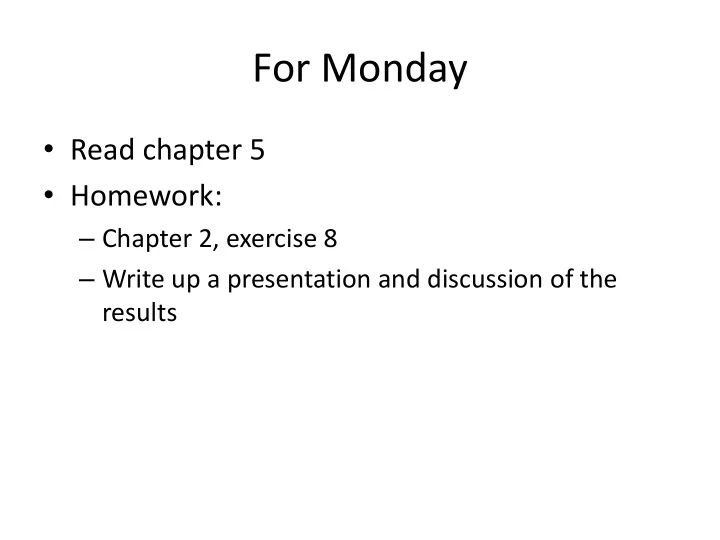

For Monday • Read chapter 5 • Homework: – Chapter 2, exercise 8 – Write up a presentation and discussion of the results
Program 1
Late Tickets • There are 2 • You all know how they work • 5 days as usual
Machine Learning Research • What do we do?
Good Experimentation • Training • Testing • Learning Curves • Significance
The Standard Paper • Introduction • Background • The new thing • Experiment – Describe data – Present results – Discuss results • Related Work • Future Work • Conclusion
Backpropogation Learning Algorithm • Create a three layer network with N hidden units and fully connect input units to hidden units and hidden units to output units with small random weights. Until all examples produce the correct output within e or the mean-squared error ceases to decrease (or other termination criteria): Begin epoch For each example in training set do: Compute the network output for this example. Compute the error between this output and the correct output. Backpropagate this error and adjust weights to decrease this error. End epoch • Since continuous outputs only approach 0 or 1 in the limit, must allow for some e-approximation to learn binary functions.
Comments on Training • There is no guarantee of convergence, may oscillate or reach a local minima. • However, in practice many large networks can be adequately trained on large amounts of data for realistic problems. • Many epochs (thousands) may be needed for adequate training, large data sets may require hours or days of CPU time. • Termination criteria can be: – Fixed number of epochs – Threshold on training set error
Representational Power Multi-layer sigmoidal networks are very expressive. • Boolean functions : Any Boolean function can be represented by a three layer network by simulating a two-layer AND-OR network. But number of required hidden units can grow exponentially in the number of inputs. • Continuous functions : Any bounded continuous function can be approximated with arbitrarily small error by a two-layer network. Sigmoid functions provide a set of basis functions from which arbitrary functions can be composed, just as any function can be represented by a sum of sine waves in Fourier analysis. • Arbitrary functions : Any function can be approximated to arbitrary accuracy by a three-layer network.
Sample Learned XOR Network 3.11 6.96 -7.38 -2.03 -5.24 B A -3.58 -5.57 -3.6 -5.74 X Y Hidden unit A represents ¬(X Y) Hidden unit B represents ¬(X Y) A ¬B Output O represents: ¬(X Y) (X Y) X Y
Hidden Unit Representations • Trained hidden units can be seen as newly constructed features that re-represent the examples so that they are linearly separable. • On many real problems, hidden units can end up representing interesting recognizable features such as vowel-detectors, edge-detectors, etc. • However, particularly with many hidden units, they become more “distributed” and are hard to interpret.
Input/Output Coding • Appropriate coding of inputs and outputs can make learning problem easier and improve generalization. • Best to encode each binary feature as a separate input unit and for multi-valued features include one binary unit per value rather than trying to encode input information in fewer units using binary coding or continuous values.
I/O Coding cont. • Continuous inputs can be handled by a single input by scaling them between 0 and 1. • For disjoint categorization problems, best to have one output unit per category rather than encoding n categories into log n bits. Continuous output values then represent certainty in various categories. Assign test cases to the category with the highest output. • Continuous outputs (regression) can also be handled by scaling between 0 and 1.
Learning Issues • Number of examples • Number of hidden layers • Number of hidden units
Auto-Associative Network
Recurring Network
Recommend
More recommend